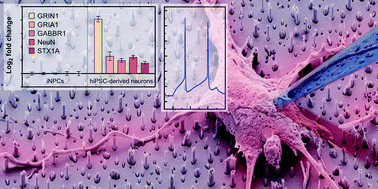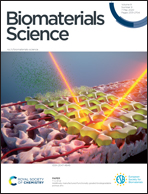Interfacing human induced pluripotent stem cell-derived neurons with designed nanowire arrays as a future platform for medical applications†
Abstract
Nanostructured substrates such as nanowire arrays form a powerful tool for building next-generation medical devices. So far, human pluripotent stem cell-derived neurons—a revolutionary tool for studying physiological function and modeling neurodegenerative diseases—have not been applied to such innovative substrates, due to the highly demanding nature of stem cell quality control and directed differentiation procedures to generate specialized cell types. Our study closes this gap, by presenting electrophysiologically mature human pluripotent stem cell-derived neurons on a set of nanowires in different patterns and growth densities after only four weeks of maturation—thereof 14 to 16 days on the nanowire arrays. While cell viability is maintained on all nanowire substrates, the settling regime of the cells can be controlled and tuned by the nanowire density from a fakir-like state to a complete nanowire wrapping state. Especially, full electrophysiological integrity of the neurons independent of the settling regime has been revealed by patch clamp experiments showing characteristic action potentials. Based on these results, our protocol has the potential to open new pathways in stem cell research and regenerative medicine utilizing human stem cell-derived neurons on tailor-made nanostructured substrates.



 Please wait while we load your content...
Please wait while we load your content...